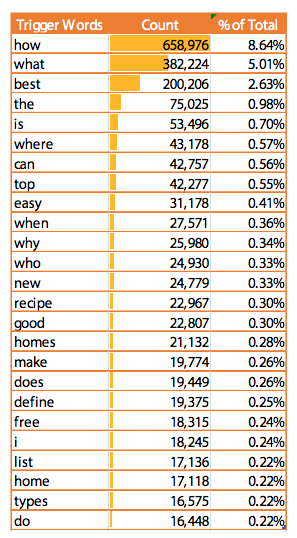SEO is Not Dead
The search industry has been suffering under “SEO is Dead” headlines for ages. If that were true, SEO jobs wouldn’t be growing 5 times faster than the overall job market. By now, most SEOs consider this headline mere clickbait, but there is a small grain of truth in these article titles.
SEO is continually evolving into something new and different. It’s not dead by any means, but the old way of optimizing for search engines is constantly dying and being reborn. Search engine optimization is the phoenix of digital marketing. Part of being an SEO is rolling with Google’s punches, learning as much as you can as fast as you can, and adjusting your strategy accordingly.
Blueprints that worked for SEOs almost 20 years ago are now “black hat.” Just like strategies that work today will probably be obsolete in another 5 years.
Google Dictates Search Trends
A good SEO will tell you his or her strategy is not to “beat the algorithm,” but instead serve the same purpose that Google aims to serve. Google states that it’s mission is to “organize the world’s information and make it universally accessible and useful.” The search giant is working it’s hardest to make its search engine the easiest to use, the most intuitive, and user-friendly.
The relationship between Google and websites is actually a partnership. With no information to feed searchers, Google would not exists. Websites serve as the information that Google organizes and makes accessible to users.
However, because Google has become the giant that it has (imagine if your brand name was synonymous with what your product or service actually does!), websites are often at the mercy of what Google deems relevant. We’ve seen this fail in the past (Google Glass, Google Reader, Google Authorship in SERPs, etc.), but when Google gets it right, it changes search from that point on.
Voice Search is the Now of SEO
Whether we’ve been paying attention or not, Google has been slowly evolving into a voice search engine–it’s first semantic search patent dates back to 1999. This is sort of a chicken and the egg situation. It’s hard to say if Google’s technology caused the advent of voice search or if humanity has been moving toward it while Google is just anticipating it. It’s sort of intertwined at this point.
However, features like Google My Business local pack listings, the featured snippet, and knowledge graph are all steps toward voice search’s “single answer” or “position zero.” Google has been slowly conditioning SEOs and digital marketers to prepare themselves for voice search.
Now voice technology like Google’s Home that can make calls means we have the tools to truly connect our searching with our everyday lives. At the 2016 Google I/O, they announced that “20 percent of all searches have voice intent.” ComScore predicts that half or more of total online searches will be made by voice in 2020.
In the release video for Google Home, the user says, “Hey, Google, call that sandwich shop on Pierce Street.” The implications this technology has on everyday life are endless. For now, there are slight limitations in how technology like Home works. But the idea is that one day this will be part of everyone’s routine. Tools like Home will serve as an actual assistant–helping users find answers, make reservations, book meetings, call local businesses, and much more.
Who knows what the future will look like? Will there be websites at all anymore? Will SEOs optimize for a Jetson’s home where information only exists in the cloud? Probably not anytime soon. For now, there are technical and content elements that SEOs can work toward in order to rank for this single answer that will be served in voice search results.
Technical SEO for Voice Search
Before you can optimize your technical, on-page SEO specifically for voice search, it’s important to make certain your general on-page SEO is in check. If things like crawlability are affected by your technical setup, then your site will have an issue ranking in the first place.
Prepare Your Site for Mobile-First Indexing
Google’s mobile-first index is due to be unveiled in 2018. In a mobile first world, Google will crawl pages across the internet from the point of view of a mobile device as opposed to a desktop computer. This means that sites that aren’t up to scruff on mobile will probably be ranked lower than sites that have responsive, fast-loading sites.
Last year, Google said 20 percent of voice searches came from a mobile device. That number is probably higher now. This just underscores the importance of preparing your site for the mobile-first index. If Siri or Bixby are offering users a single answer to queries, than having a mobile-ready site will put you potentially higher on the SERP
This is especially crucial for small and local businesses. A report from Digital Marketing Depot states that, “As much as 22 percent of voice queries inquire about local information such as directions, restaurants, shopping, local services, weather, local events, traffic, etc.” This primer from LSA Insider shows how local businesses can prepare for mobile-first indexing, but my main recommendation is to get a responsive site.
Pagespeed is a Ranking Factor
Google has confirmed that when mobile-first indexing rolls out pagespeed will be a ranking factor. Tools like Google’s PageSpeed Insights and GTMetrix can give developers insights into which elements of their sites are slowing down pagespeed on both desktop and mobile.
Embedded content: https://twitter.com/jenstar/status/844591942654574592
Surveys have shown that “half of web users expect a site to load in 2 seconds or less, and they tend to abandon a site that isn’t loaded within 3 seconds.” User experience signals are part of the data Google uses to determine if a result is actually serving the needs of searchers. If a lot of users click a top result, then immediately return to search results, choose a result lower on the SERP, and stay there, this tells Google that for that query, the lower result actually serves users’ needs better.
SEOs can work with developers on best practices for optimizing for site speed. This is often a larger task that involves web development to ensure that things are done correctly and effectively.
Add Structured Markup… If You Have the Resources
This is not a requirement to rank in a featured snippet. In fact, CallRail has ranked in featured snippets without specific schema markup. But it’s one of those elements of SEO and development that can’t hurt, and it’s better to implement sooner than wait until your site has hundreds of pages.
Because SEO is constantly evolving, you never know what element would be the most useful. However, if you don’t have the resources to do this step, it’s one of those that should take a back burner to more important actions. A lack of structured data won’t be the deciding factor in whether your site is presented as an answer on voice search results. The actual site content is more of a determining factor…
Creating Content for Voice Search
One of the most important elements in optimizing your site for voice search is to develop the kind of content that specifically answers questions. The Digital Marketing Depot study showed that a certain set of words in a query can trigger the featured answer. These are the same types of words that people using when actually asking questions in person. Therefore, it’s important to use the language that your target audience is using to search.
Optimizing your content around voice-centered user intent will help you show up as “the” answer when someone asks their Google Home or Amazon Echo a question. Unlike in SERPs with screens, voice search doesn’t present the classic “10 blue links,” but a single, definitive answer.
Voice search also gives writers and content marketers a chance to really go after and explain the topics in their industries in detail. Answering specific, tailored questions with comprehensive and detailed posts can give you an advantage against others looking to capitalize on the voice search game.
Optimizing content for voice includes two specific components:
- Format your keyword/topic strategy around long-tail keywords, and
- Use a question and answer format.
When you think about optimizing for the trigger words on the left, the specific questions that humans as search engines are often not as broad as “What is ________?” Tools like Answer the Public can detail the longer tail, specific questions that people ask about your industry–and you can use those queries to create the content that people are looking for.
I did a quick search for “install a ceiling fan” and got a list of 156 related questions that people ask search engines (maybe even mid-install!) about specifics they may not be able to find in other places: how to install a ceiling fan without attic access; when hanging a ceiling fan what is the red wire for; and where to install bathroom ceiling fan.
When you’re the one who provides the help in the middle of the smaller tasks, you’ll become the go-to for help with the larger tasks, too. Part of the appeal of voice search is that you’re reaching users at all levels of the funnel. People use voice search for all of Google’s micro-moments. Creating a content strategy based on each of these moments will help in the voice search landscape as well.
Call Tracking is More Important Than Ever Now
Because voice search is more than likely going to lead to more direct calls (especially for local businesses), it’s crucial that businesses who want a more holistic attribution model figure out their call tracking solution. Businesses can use mainline tracking numbers across their online directory profiles. This will help maintain NAP consistency and allow you to track and record calls specifically from places like Google My Business and Yelp.
BIA/Kelsey data shows that “phone calls are the new click” in digital marketing. Google’s evolution toward voice search is one small step toward potentially more calls for businesses. Experts are predicting that home assistants will likely become a sort of resurgence for landline-like phone devices. Tracking calls from these devices is crucial for businesses and agencies to track leads, prove ROI, improve sales/support interactions, and ultimately grow the bottom line.
To learn more about voice search, check out this podcast with Greg Sterling,VP of Strategy and Insights at Local Search Association, and Mark Sullivan, Director of Demand Generation at CallRail.
Learn more about how call tracking and attribution can grow your business in the era of voice search–request your no obligation demo of CallRail, or go ahead and start your 14 Day Free Trial, no credit card needed.














